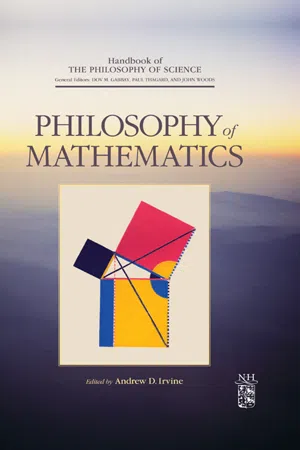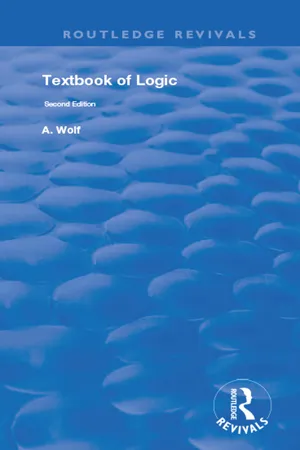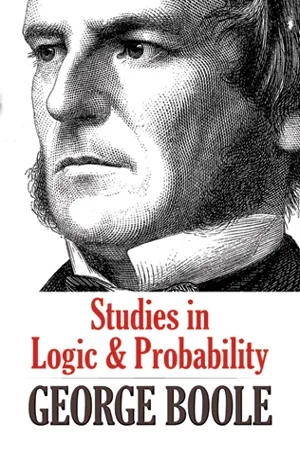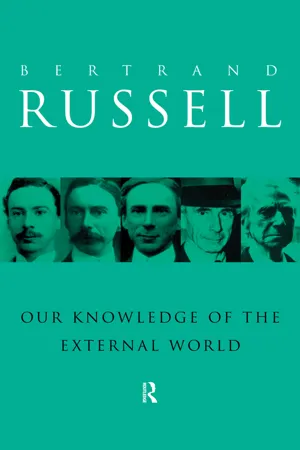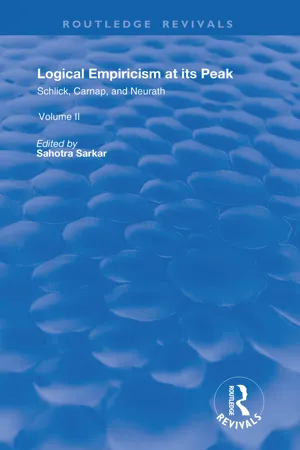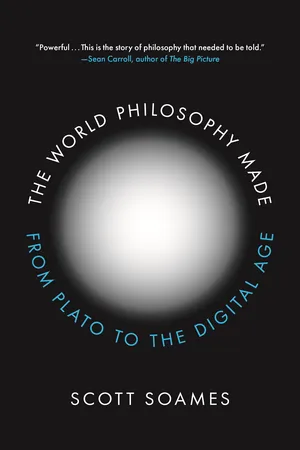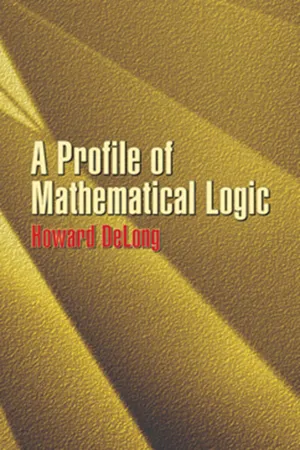Mathematics
Logic
Logic in mathematics refers to the systematic study of valid reasoning and inference. It involves the use of formal systems to determine the truth or falsity of mathematical statements. By employing logical principles and rules, mathematicians can construct rigorous proofs and make sound conclusions about the properties and relationships of mathematical objects.
Written by Perlego with AI-assistance
Related key terms
10 Key excerpts on "Logic"
- eBook - ePub
- Dov M. Gabbay, Paul Thagard, John Woods(Authors)
- 2009(Publication Date)
- North Holland(Publisher)
Such characterizations leave a large number of loose ends, however. For one thing, it is not clear precisely what is supposed to be reduced to precisely what. Hempel’s formulation speaks of a deduction of mathematical theorems from the principles of Logic. This presupposes that mathematical theorems and Logical principles are commensurate at least to the extent that the former can be deduced from the latter. But mathematical and Logical systems are not in fact commensurate in a natural and widely accepted perspective. Mathematical theorems deal with what is true in a certain structure, for instance, in the structure of natural numbers or in that of real numbers. In contrast, Logical principles deal with Logical truths. These are not a subclass of truths simpliciter, that is truths in some one structure. They are truths in every possible structure. They can be considered empty or “tautoLogical”, just because they do not exclude any possibilities. How could mathematical truths possibly be deduced from them? The difference is among other things illustrated by the fact that the inference rules used in systematizing the two kinds of truth can be different. For instance, some actually used inference rules in Logic that preserve Logical truth but do not preserve ordinary truth.This problem did not bother early Logicists like Frege and Russell, for whom Logical truths were simply the most general truths about the world. But as soon as one is forced to distinguish between Logical truth and truth simpliciter, a Logicist is in for a serious difficulty. Hence the very conception of Logical truth presupposed by Frege and Russell points to a difficulty in the Logicist position.These problems lead us to the two fundamental questions on which any examination and evaluation of Logicism crucially depends: What is mathematics? What is meant by Logic? It is important to realize that the meaning and the reference of both of these crucial terms has changed in the course of history. This makes the force of the term “Logicism” also dependent on the historical context in which it is being applied.2 WHAT IS MATHEMATICS?
One important change in the meaning of mathematics was beginning to take place at the very time Logicism first became an important movement in the philosophy of Logic through the efforts of Frege and Russell. According to the earlier view, mathematics has two subject matters, number and space. The two most basic parts of mathematics are therefore arithmetic and geometry. Admittedly, the concept of number was generalized so as to include real numbers and complex numbers. Accordingly, arithmetic was extended to infinitesimal or “higher” analysis. Yet, in spite of this tremendous growth of mathematics, someone like Leopold Kronecker (1823–1891) could still maintain that natural numbers are at the bottom of all mathematics. - eBook - ePub
- Wolf Abraham(Author)
- 2019(Publication Date)
- Routledge(Publisher)
inferences not of beliefs generally.The terms inference and reasoning are frequently used as synonyms. It is better, however, to distinguish between them. People frequently jump to conclusions quite uncritically, without deliberation. At other times, in cases of special difficulty or importance, they proceed more cautiously, and carefully weigh the evidence for and against. It is best to confine the term reasoning to such deliberate reflection or critical inference. Strictly speaking, Logic is mainly concerned with reasoning in the sense just explained. Uncritical (or unreflective) inferences are as a rule neither controlled nor studied, except sometimes after the event. That is why they are frequently so mischievous.A word may be added here about the relation of inference to proof, which terms appear almost as synonyms in the definition of Logic given above. In every argument there are two things: (1) the premises (or data, or evidence) and (2) the conclusion (or the inference). The conclusion is inferred from the evidence, and, if it is inferred accurately, the evidence is said to prove the conclusion. Thus valid inference and proof are simply different aspects of the same thing. If we start from the evidence (or premises) and proceed to the conclusion the process is called inference; but if we begin by entertaining some belief or suggestion and proceed to justify it by means of suitable evidence, the process is called proof. It is common, however, to make this further distinction between inference and proof. The term proof is usually restricted to correct proof, whereas the term inference is applied to incorrect as well as to correct inference. Thus, for example, inference from analogy is a very common type of inference (or of reasoning), but it is no proof, as will be explained in due course. Another point worth noting here is that the term reasoning is commonly applied to both (reflective) inference and proof - eBook - ePub
- Marcel Danesi(Author)
- 2016(Publication Date)
- De Gruyter Mouton(Publisher)
2LogicLogic will get you from A to B. Imagination will take you everywhere .Albert Einstein (1879–1955)Introductory remarks
Formal linguistics and mathematics focus on the rules, rule types, and rule-making principles that undergird the formation of forms (words, digits, sentences, equations). Both have developed very precise methods to describe the relevant apparatus of rules and their operations. An obvious question is what similarities or differences exist between the two. As we saw in the previous chapter, formalist approaches have actually revealed many similarities traceable to a common foundation in Logic. As a matter of fact, formal linguistics implies formal mathematics thus uniting the two disciplines, ipso facto, at least at the level of the study of rules. If the focus is on the latter, then indeed formalism is of some value; if it is deemed to be an overt or indirect theory of mind, as for example UG theory, then its value is diminished, unless the theory can be validated empirically. This chapter will look more closely at the main techniques and premises that underlie both formal mathematics and formal linguistics, as well as at the main critiques that can be (and have been) leveled at them.Language and mathematics were thought in antiquity to share a common ground in lógos , which meant both “word” and “thought.” The main manifestation of this mental feature was in Logic and this, in turn, was the basis of linguistic grammars and mathematical proofs. As we saw, Aristotle and Dionysius Thrax, envisioned language as a Logically structured system of grammatical rules of sentence formation (Bäck 2000, Kempe 1986), in an analogous way that Pythagoras and Euclid envisioned mathematical proofs as a set of statements that followed from each other Logically. The term lógos emerged in the sixth-century BCE with the philosopher Heraclitus, who defined it as a “divine power” that produced order in the flux of Nature. Through the faculty of Logic, all human beings, he suggested, shared this power. The Greeks thus came to see Logic as a unique intellectual endowment allowing humans to transform intuitive and practical observations about the world into general principles. They separated lógos from mythos - eBook - ePub
- Robert M. Exner, Myron F. Rosskopf(Authors)
- 2011(Publication Date)
- Dover Publications(Publisher)
a . An efficient means of exposition, andb . An efficient means of organizing its subject matter.1In what follows, we shall be concerned with this formal, Logical side of mathematics. The Logic provides a symbolic language with which to talk about mathematics with ease and precision. We shall also have to introduce a symbolic language in order to talk about the Logic with ease and precision.We shall have little to say in this book about the creative, conjectural side of mathematics, but this should not be construed as indicating any judgment about the relative importance of the formal side and the creative side of mathematics. Both sides are essential to the discipline.1 A prime number is an integer that has no positive integral factors other than itself and one. For various reasons, it is best to exclude 1 from the set of primes, although it meets the requirements of the definition.1 Of course, Logic also provides these means for the sciences and other disciplines which use them in varying degrees and with varying success.1.2 FORM AND MEANING
Consider the case of a mathematician who has arrived at a reasonable conjecture. However plausible or seductive the conjecture, he must view it with suspicion until he knows whether it is “true”. We use quotation marks here because in this case “truth” means consistency with the body of accepted mathematical statements. To verify this consistency, the mathematician tries to construct a proof that will show that the statement of the conjecture follows Logically - eBook - ePub
- George Boole(Author)
- 2012(Publication Date)
- Dover Publications(Publisher)
At the same time, it is to be observed that whether we adopt the ostensive or what I have termed the noetic view of the Science of Logic, the foundations of that science must equally be laid in an analysis of the laws of the intellectual operations. . . . [In the discussion of the Laws of Conception, which comes soon after this passage, Boole emphasizes particularly the special conditions to which the four different operations of Conception—Addition, Subtraction, Composition and Abstraction—are subject. After that comes the analysis of Judgment, and then the section on Reasoning.] Analysis of Reasoning as exercised within the sphere of Formal Logic The office of Reason is to determine the inferential succession of propositions. Moreover, a proposition is in Formal Logic an affirmation of identity; it asserts that it is to the same object—to the same individual things —that two concepts in thought, or two terms (properly limited) in language, refer. Logical Reasoning, therefore, is specially concerned with the notion of identity; and it might with propriety be said to consist in the operations which arise from the development of that notion. But as the identity with which Logical reasoning is concerned is the identity of things, which, as represented by the terms of the proposition, have become the subjects of Conception, under the general notion of Class and in subjection to the formal laws and relations therewith connected, we are ultimately conducted to the following definition, viz : Logical reasoning is a process of formal inference applied to propositions considered as affirmations of the identity of the things which, as conceived by us under the notion of Class, are expressed in the connected terms of propositions - eBook - ePub
- Bertrand Russell(Author)
- 2014(Publication Date)
- Routledge(Publisher)
Lecture II Logic as the Essence of PhilosophyTHE topics we discussed in our first lecture, and the topics we shall discuss later, all reduce themselves, in so far as they are genuinely philosophical, to problems of Logic. This is not due to any accident, but to the fact that every philosophical problem, when it is subjected to the necessary analysis and purification, is found either to be not really philosophical at all, or else to be, in the sense in which we are using the word, Logical. But as the word “Logic” is never used in the same sense by two different philosophers, some explanation of what I mean by the word is indispensable at the outset.Logic, in the Middle Ages, and down to the present day in teaching, meant no more than a scholastic collection of technical terms and rules of syllogistic inference. Aristotle had spoken, and it was the part of humbler men merely to repeat the lesson after him. The trivial nonsense embodied in this tradition is still set in examinations, and defended by eminent authorities as an excellent “propaedeutic,” i.e. a training in those habits of solemn humbug which are so great a help in later life. But it is not this that I mean to praise in saying that all philosophy is Logic. Ever since the beginning of the seventeenth century, all vigorous minds that have concerned themselves with inference have abandoned the mediaeval tradition, and in one way or other have widened the scope of Logic.The first extension was the introduction of the inductive method by Bacon and Galileo—by the former in a theoretical and largely mistaken form, by the latter in actual use in establishing the foundations of modern physics and astronomy. This is probably the only extension of the old Logic which has become familiar to the general educated public. But induction, important as it is when regarded as a method of investigation, does not seem to remain when its work is done: in the final form of a perfected science, it would seem that everything ought to be deductive. If induction remains at all, which is a difficult question, it will remain merely as one of the principles according to which deductions are effected. Thus the ultimate result of the introduction of the inductive method seems not the creation of a new kind of non-deductive reasoning, but rather the widening of the scope of deduction by pointing out a way of deducing which is certainly not syllogistic, and does not fit into the mediaeval scheme. - eBook - ePub
Logical Empiricism at Its Peak
Schlick, Carnap, and Neurath
- Maria Neurath, Sahotra Sarkar, Moritz Schlick, Rudolf Carnap, Sahotra Sarkar, Sahotra Sarkar(Authors)
- 2021(Publication Date)
- Routledge(Publisher)
not postulated but constructed. The Logicist does not establish the existence of structures which have the properties of the real numbers by laying down axioms or postulates; rather, through explicit definitions, he produces Logical constructions that have, by virtue of these definitions, the usual properties of the real numbers. As there are no “creative definitions,” definition is not creation but only name-giving to something whose existence has already been established.In similarly constructivistic fashion, the Logicist introduces the rest of the concepts of mathematics, those of analysis (e.g., convergence, limit, continuity, differential, quotient, integral, etc.) and also those of set theory (notably the concepts of the transfinite cardinal and ordinal numbers). This “constructivist” method forms part of the very texture of Logicism.II. The derivation of the theorems of mathematics
The second thesis of Logicism is that the theorems of mathematics are derivable from Logical axioms through Logical deduction. The requisite system of Logical axioms, obtained by simplifying Russell’s system, contains four axioms of propositional calculus and two of functional calculus. The rules of inference are a rule of substitution and a rule of implication (the modus ponens of ancient Logic). Hilbert and Ackermann have used these same axioms and rules of inference in their system.Mathematical predicates are introduced by explicit definitions. Since an explicit definition is nothing but a convention to employ a new, usually much shorter, way of writing something, the definiens or the new way of writing it can always be eliminated. Therefore, as every sentence of mathematics can be translated into a sentence which contains only the primitive Logical predicates already mentioned, this second thesis can be restated thus: Every provable mathematical sentence is translatable into a sentence which contains only primitive Logical symbols and which is provable in Logic.But the derivation of the theorems of mathematics poses certain difficulties for Logicism. In the first place it turns out that some theorems of arithmetic and set theory, if interpreted in the usual way, require for their proof besides the Logical axioms still other special axioms known as the axiom of infinity and the axiom of choice (or multiplicative axiom). The axiom of infinity states that for every natural number there is a greater one. The axiom of choice states that for every set of disjoint nonempty sets, there is (at least) one selection-set, i.e., a set that has exactly one member in common with each of the member sets. But we are not concerned here with the content of these axioms but with their Logical character. Both are existential sentences. Hence, Russell was right in hesitating to present them as Logical axioms, for Logic deals only with possible entities and cannot make assertions about whether something does or does not exist. Russell found a way out of this difficulty. He reasoned that since mathematics was also a purely formal science, it too could make only conditional, not categorical, statements about existence: if certain structures exist, then there also exist certain other structures whose existence follows Logically from the existence of the former. For this reason he transformed a mathematical sentence, say S, the proof of which required the axiom of infinity, I, or the axiom of choice, C, into a conditional sentence; hence S is taken to assert not S, but I⊃S or C⊃S - eBook - ePub
The World Philosophy Made
From Plato to the Digital Age
- Scott Soames(Author)
- 2019(Publication Date)
- Princeton University Press(Publisher)
In 1879, his Begriffsschrift (Concept Script) presented the new system of symbolic Logic now called “the predicate calculus,” the expressive power of which vastly surpassed that of any previous system. The greatest advance in the history of the subject, its rigorous formulation rendered it capable of fully formalizing the notion of proof in mathematics. 2 Frege’s Logic combined the simple truth-functional Logic (governing reasoning involving ‘and’, ‘or’, ‘not’, and ‘if, then’), known from the Stoics onward, with a powerful new account of reasoning involving ‘all’ and ‘some’, supplanting the far more limited syllogistic Logic dating back to Aristotle. Whereas Aristotle’s theory of Logical syllogisms covered only a small number of simple inferences of the sort (i) All human beings are mortal, Cleopatra is a human being, therefore Cleopatra is mortal. and (ii) Some philosophers are Logicians, all Logicians are mathematicians, therefore some philosophers are mathematicians. Frege’s Logic vastly expanded the number of valid inference patterns, dwarfing those identified by earlier Logicians. A Logic in his modern sense consists of precisely defined sets of sentences and formulas plus a proof procedure, typically consisting of axioms and rules of inference. Axioms are statements the truth of which is transparently obvious. Rules of inference—e.g., from A and If A, then B one may infer B— tell you what lines you may add to a proof-in-progress by inspecting earlier lines of the proof. A proof is, by definition, a finite sequence of lines, each of which is either an axiom or a formula obtainable from earlier lines by one of the rules of inference. A proof of Q from P is such a sequence of lines, starting with P and ending with Q. Whether or not something is a proof (in the sense of establishing that Q can’t be false if P is true) is always decidable merely by inspecting the formula on each line, without worrying about which objects and properties its expressions stand for - eBook - ePub
- Morris Kline(Author)
- 2013(Publication Date)
- Dover Publications(Publisher)
The mathematician also takes care to state his axioms at the outset and to be sure as he performs his reasoning that no assumptions or facts are used which were not so stated. There is an interesting story told by former President Charles W. Eliot of Harvard which illustrates the likelihood of introducing unwarranted premises. He entered a crowded restaurant and handed his hat to the doorman. When he came out, the doorman at once picked Eliot’s hat out of hundreds on the racks and gave it to him. He was amazed that the doorman could remember so well and asked him, “How did you know that was my hat?” “I didn’t,” replied the doorman. “Why, then, did you hand it to me?” The doorman’s reply was, “Because you handed it to me, sir.”Undoubtedly no harm would have been done if the doorman had assumed that the hat he returned to President Eliot belonged to the man. But the mathematician interested in obtaining conclusions about the physical world might be wasting his time if he unwittingly introduced an assumption that he had no right to makeThere is one other element in the Logical structure of mathematics about which we shall say a few words now and return to in a later chapter (Chapter 20 ). Like other studies mathematics uses definitions. Whenever we have occasion to use a concept whose description requires a lengthy statement, we introduce a single word or phrase to replace that lengthy statement. For example, we may wish to talk about the figure which consists of three distinct points which do not lie on the same straight line and of the line segments joining these points. It is convenient to introduce the word triangle to represent this long description. Likewise the word circle represents the set of all points which are at a fixed distance from a definite point. The definite point is called the center, and the fixed distance is called the radius. Definitions promote brevity.EXERCISES
1. What belief did the Greeks hold about the axioms of mathematics? 2. Summarize the changes which the Greeks made in the nature of mathematics. 3. Is it fair to say that mathematics is the child of philosophy?3–7 THE CREATION OF MATHEMATICS
Because mathematical proof is strictly deductive and merely reasonable or appealing arguments may not be used to establish a conclusion, mathematics has been described as a deductive science, or as the science which derives necessary conclusions, that is, conclusions which necessarily or inevitably follow from the axioms. This description of mathematics is incomplete. Mathematicians must also discover what to prove and how to go about establishing proofs. These processes are also part of mathematics and they are not - eBook - ePub
- Howard DeLong(Author)
- 2012(Publication Date)
- Dover Publications(Publisher)
CHAPTER 3MATHEMATICAL Logic
§14 INTRODUCTION
The new birth of Logic was not due to one man or even to thinkers in one country. The contributors are numerous and their interrelations complex. Hence we must abandon the historical style of the previous chapters. There the simplicity of our story was somewhat forgivable because of the paucity of evidence or primary researchers. Now, however, the sources of evidence are rich, and we shall never reach our goal if we continue to indulge in the luxury of history.12 Suffice it to say that the awakening of Logic began with George Boole (1815-1864) and Augustus De Morgan (1806-1871). The most important early work, however, was the Begriffsschrift [1879] of Gottlob Frege (1848-1925). From then on the development was very rapid. The work of Schröder (1841-1902), Peirce (1839-1914), and Peano (1858-1932) paved the way for the great systematization of Principia Mathematica [1910-1913] due to Whitehead (1861-1947) and Russell. Subsequently, the new area of what was later called metaLogic developed: the work of Löwenheim [1915], Skolem [1920 ff], Gödel [1930 ff], Tarski [1929 ff], Post [1936 ff], Church [1936 ff], Kleene [1936 ff], Turing [1936 ff], and Cohen [1963] virtually created a new universe. It is the developments in this area which have proved to be the most philosophically exciting, and which we shall describe in Chapter 4. Here we turn to a description of the Logical systems on which the metaLogical results are based.There were essentially two methods of mathematics which transformed Logic into a new discipline. The first was the algebraic method, in which relations between mathematical entities are reflected in the relationships which hold between the symbols for these entities. Thus new relationships between mathematical entities can be discovered by manipulation of the symbols in accordance with certain rules. The second was the axiomatic method. What is meant here by the phrase axiomatic method is not the method that Euclid used, but a revision of that method based on various insights and discoveries made since his time. To distinguish it from Euclid’s, it is often called the formal axiomatic method.
Index pages curate the most relevant extracts from our library of academic textbooks. They’ve been created using an in-house natural language model (NLM), each adding context and meaning to key research topics.
